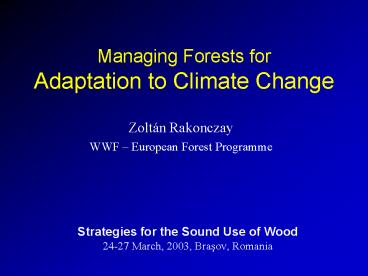Managing Forests for Adaptation to Climate Change - PowerPoint PPT Presentation
Title:
Managing Forests for Adaptation to Climate Change
Description:
Title: FSC - a Powerful Tool for the Promotion of Close-to-Nature Forest Management Author: Rakonczay Zolt n Last modified by: Rakonczay Zolt n – PowerPoint PPT presentation
Number of Views:88
Avg rating:3.0/5.0
Title: Managing Forests for Adaptation to Climate Change
1
Managing Forests forAdaptation to Climate Change
- Zoltán Rakonczay
- WWF European Forest Programme
- Strategies for the Sound Use of Wood24-27
March, 2003, Brasov, Romania
2
Outline
- Climate Change and Impacts on Forests
- Natural Adaptation Mechanisms
- Adaptation Measures
- Implications for the Use of Wood
3
Climate Change is Happening
- An increasing body of observations gives a
collective picture of a warming world and other
changes in the climate system (IPCC TAR) - It is very likely to be happening
- Caused by anthropogenic sources of GHGs
- Burning of fossil fuels is the main culprit (CO2)
- Main issues adaptation and mitigation
4
(No Transcript)
5
Changes in the Environment
- Temperatures are likely to increase
- (0.1-0.4C/decade)
- Precipitation
- increase in the north, decrease in the south
- changed seasonal pattern
- Extreme weather events more frequent
- storms, floods, droughts
- Increased CO2 concentration
6
(No Transcript)
7
(No Transcript)
8
Likely Impacts on Forests
- Shifting range boundaries
- towards the north
- towards higher elevations
- Changes in phenology
- lengthening of the growing season
- higher evapotranspiration
- functional groups may disintegrate due to
differing responses to environmental change
9
Likely Impacts on Forests (2)
- Changes in the carbon balance (???)
- higher growth (initially?)
- higher decomposition/respiration (!)
- Increased incidents of abiotic damage
- windthrow, fire, snow/ice
- Increased incidents of biotic damage
- new pests moving in
- increased susceptibility due to stress
10
(No Transcript)
11
Adaptation Mechanisms
- Physiological acclimation
- trees can tolerate changes within the historic
range of environmental variability - exceeding this range can be catastrophic
12
(No Transcript)
13
Adaptation Mechanisms
- Physiological acclimation
- trees can tolerate changes within the historic
range of environmental variability - exceeding this range can be catastrophic
- In-situ evolution
- typically a slow process, many life cycles
- adequate genetic diversity is a prerequisite
- losses of diversity (on the short run)
- speciation (on the long run)
14
Adaptation Mechanisms (2)
- Migration
- the most effective adaptation strategy by far
- requires freedom of movement along environmental
gradients - rate of change is a crucial factor
- functional groups have to migrate together
(keystone species) - Refugia
- areas where the special microclimate allowed the
survival of species
15
What is Special AboutCurrent Climate Change?
- The rate of change seems to be extraordinarily
fast - The landscape is no longer pristine
- fragmentation
- altered ecosystems
- degraded/stressed ecosystems
- invasive/introduced species
- Ecosystems serve basic human needs
- we cannot afford losing crucial functions
16
Implications for the Use of Forest (use of wood -
broad sense)
- Biomass use for energy
- fossil fuel substitution
- Carbon sequestration
- lack of use of wood
- Adaptation measures
- protection/management of forest for biodiversity
benefits - to secure services for the long run
For global climate benefits
17
Adaptation Measures
- Nature reserves
- sufficient size
- full range of forest types
- Connectivity
- avoid fragmentation
- restore connectivity (corridors)
- Protect climatic refugia / migration corridors
- different scales (microhabitats to ecoregions)
- historic migration corridors are often degraded
18
Adaptation Measures (2)
- Protect primary forests
- Provide buffer zones to protected areas
- Practice low-intensity forestry
- small canopy openings to protect microclimate
- reasonably complete set of species
- Maintain genetic diversity at all levels
- Identify and protect functional groups
- Monitor changes (adapt mgmt. if needed)
19
Implications for the Use of Wood (strict sense)
- Forest utilisation should give priority to
adaptation measures - Use efficiently what forests do provide, instead
of trying to grow what you think the market will
demand in the distant future. - technological advances (targeted research)
- consumption habits of end users (marketing)
20
Conclusions
- Climate change is happening
- Forests are likely to suffer major impacts
- Adaptation should be facilitated
- recommended measures differ little from sound
management under static climate
21
Conclusions (2)
- Adaptation measures should be given priority
(precautionary principle) - Efficient use of available wood should be
promoted - novel technologies
- awareness raising / marketing
22
- Zoltán Rakonczay
- WWF Forest - Climate Change Officer
- zoltan.rakonczay_at_elender.hu
- tel 36 1 214 5554































